class Solution {
public:
long long largestSquareArea(vector<vector<int>>& bottomLeft, vector<vector<int>>& topRight) {
}
};
100225. 求交集区域内的最大正方形面积
在二维平面上存在 n 个矩形。给你两个下标从 0 开始的二维整数数组 bottomLeft 和 topRight,两个数组的大小都是 n x 2 ,其中 bottomLeft[i] 和 topRight[i] 分别代表第 i 个矩形的 左下角 和 右上角 坐标。
我们定义 向右 的方向为 x 轴正半轴(x 坐标增加),向左 的方向为 x 轴负半轴(x 坐标减少)。同样地,定义 向上 的方向为 y 轴正半轴(y 坐标增加),向下 的方向为 y 轴负半轴(y 坐标减少)。
你可以选择一个区域,该区域由两个矩形的 交集 形成。你需要找出能够放入该区域 内 的 最大 正方形面积,并选择最优解。
返回能够放入交集区域的正方形的 最大 可能面积,如果矩形之间不存在任何交集区域,则返回 0。
示例 1:

输入:bottomLeft = [[1,1],[2,2],[3,1]], topRight = [[3,3],[4,4],[6,6]] 输出:1 解释:边长为 1 的正方形可以放入矩形 0 和矩形 1 的交集区域,或矩形 1 和矩形 2 的交集区域。因此最大面积是边长 * 边长,即 1 * 1 = 1。 可以证明,边长更大的正方形无法放入任何交集区域。
示例 2:

输入:bottomLeft = [[1,1],[2,2],[1,2]], topRight = [[3,3],[4,4],[3,4]] 输出:1 解释:边长为 1 的正方形可以放入矩形 0 和矩形 1,矩形 1 和矩形 2,或所有三个矩形的交集区域。因此最大面积是边长 * 边长,即 1 * 1 = 1。 可以证明,边长更大的正方形无法放入任何交集区域。 请注意,区域可以由多于两个矩形的交集构成。
示例 3:

输入:bottomLeft = [[1,1],[3,3],[3,1]], topRight = [[2,2],[4,4],[4,2]] 输出:0 解释:不存在相交的矩形,因此,返回 0 。
提示:
n == bottomLeft.length == topRight.length2 <= n <= 103bottomLeft[i].length == topRight[i].length == 21 <= bottomLeft[i][0], bottomLeft[i][1] <= 1071 <= topRight[i][0], topRight[i][1] <= 107bottomLeft[i][0] < topRight[i][0]bottomLeft[i][1] < topRight[i][1]
原站题解